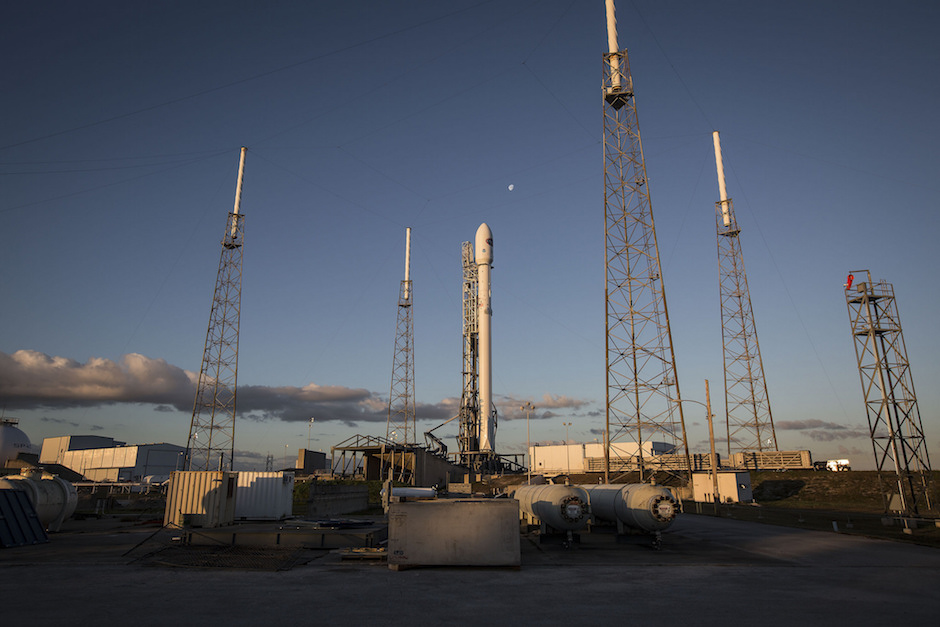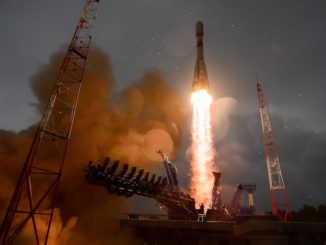
Forecasters will be watching clouds and rain showers during the countdown before Monday’s launch of a Falcon 9 rocket carrying Turkmenistan’s first communications satellite.
The 22-story rocket is set to lift off from Cape Canaveral during a 90-minute launch window opening at 6:14 p.m. EDT (2214 GMT) Monday.
The official weather outlook issued Friday by the U.S. Air Force’s 45th Weather Squadron calls for a 60 percent chance of favorable conditions during Monday’s launch window. Forecasters said their chief concerns are with thick clouds and cumulus clouds that could violate launch weather rules.
The Air Force weather team predicts isolated rain showers, scattered to broken clouds, and northwest winds at 10 to 15 mph.
The forecast worsens Tuesday, when a weather system is expected to generate widespread storms in Central Florida. There is just a 30 percent probability of good weather Tuesday, according to the Air Force.
The flight will be the Falcon 9’s fifth launch of more than a dozen planned this year, and if the rocket blasts off Monday, it will come just 13 days after SpaceX’s last mission from the same launch pad.
The achievement would best SpaceX’s turnaround time of 14 days, which came between two launches last year.

SpaceX technicians rolled the two-stage Falcon 9 rocket into the hangar at Cape Canaveral’s Complex 40 launch pad hours after another Falcon 9 went up April 14 with a Dragon supply ship for the International Space Station.
Workers mechanically and electrically connected the two-stage rocket, completed final testing, and transferred the booster to the launch pad about 600 feet north of the horizontal assembly hangar for a customary prelaunch engine hotfire test Wednesday.
The first stage’s nine Merlin 1D engines fired for a few seconds as computers checked numerous parameters to verify the kerosene-fueled powerplants are ready for launch. The rocket remained affixed to the launch pad during the firing.
Ground teams returned the rocket to the hangar to receive the TurkmenAlem52E satellite, which was fueled with in-space maneuvering propellant and enclosed inside the Falcon 9’s 17-foot diameter nose cone in a nearby SpaceX payload processing facility.
Assembled in France by Thales Alenia Space, the spacecraft will be handed over to the government of Turkmenistan after launch to become the country’s first communications satellite.
The Falcon 9 will place the five-ton satellite into an elliptical transfer orbit, then the spacecraft will raise its altitude to 22,300 miles and slide into an operational position in geosynchronous orbit at 52 degrees east longitude.
The operating post will give the satellite coverage over Europe, Central Asia and Africa for its 15-year mission, according to Thales Alenia Space.
Monaco has rights to the 52 degrees east slot to be occupied by the Turkmen satellite. In exchange for permitting the spacecraft to reside there, Monaco’s government secured the use of 12 Ku-band transponders on the satellite.
Luxembourg-based satellite operator SES signed an agreement with Space Systems International Monaco, an entity licensed by Monaco’s government, to commercialize the 12 Ku-band transponders.
The hefty payload and high-altitude destination for Monday’s mission will prevent SpaceX from attempting a recovery of the Falcon 9’s first stage booster.
Follow Stephen Clark on Twitter: @StephenClark1.



